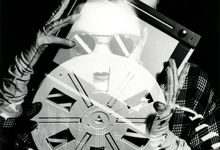- Images (3)
- Links (1)
- Agenda (0)

|

|

|

|

|

|
Maria Klonaris passed away on Monday, January 13, 2014. She and Katerina Thomadaki have been producing for more than forty years a fascinating cinematographic and plastic work, on the borders of experimental cinema, body performance, installation and technological art.
Born in Egypt in 1950 to Greek parents, both doctors, Maria Klonaris grew up in the cosmopolitan Alexandria of the 1950s. After the Suez Crisis, the family moved to Athens. Maria Klonaris attended high school at the American College. At the Athens School of Fine Arts, she received training in scenography and stage design. She publishes several albums of drawings and signs theatre posters, book covers and illustrations. She began her artistic collaboration with Katerina Thomadaki when they created and directed the Théâtre des 4, the first as set designer, the second as director (Les Bonnes, 1968; Salomé, 1969).
From the moment they moved to Paris in 1975, Klonaris and Thomadaki formed an inseparable pair. Klonaris/Thomadaki conceived vast cycles that ran over several years and developed in several artistic disciplines: Body Tetralogy, Unheimlich Cycle (around the "disquieting strangeness" of the Feminine), Hermaphrodite Cycle, Electra's Dream, Portrait Series, Angel Cycle, Sublime Disasters. The Twins... With these recurring figures that are out of the ordinary, they question the frontier between the sexes. Well before the emergence of the queer movement, Klonaris/Thomadaki's work, nourished by critical thought (psychoanalysis, philosophy, sociology, feminist thought...), looks at gender and intersexuality.
As a teenager, Maria Klonaris discovered the clinical photograph of a hermaphrodite in the archives of her father, a gynaecologist and obstetrician. It will be the generating figure of their largest cycle. This image of the "angel" has been part of a series of works since 1985: immersive installations, artists' books, photographs and videos. In the video Requiem pour le XXe siècle (1993), Klonaris/Thomadaki juxtaposed it with archival images from the Second World War, demonstrating that through this "marginal" figure, it is in fact about questioning the whole of humanity: "Wandering and motionless consciousness, in the face of the events that explode before his abolished gaze, the Angel becomes in turn observer, witness, victim and judge, a different body persecuted, burnt knowledge, irradiated body, scene of memory."
By combining "expanded cinema" and in-situ work, Klonaris/Thomadaki develop installations and projection environments, often monumental, in museums or abandoned places. Examples include Mystère I: Hermaphrodite endormi/e (Paris, 1982), Le Rêve d'Electra (Villeneuve-Lès-Avignon, 1986), Night Show for Angel (London, 1992), XYXX: Mosaic Identity (Linz, 1994), Stranger than angel (Ljubljana, 2002).
The political dimension of Klonaris/Thomadaki's work is always combined with a force of plastic revelation. The philosopher Marie-José Mondzain has underlined the paradoxical alliance of a high tradition of the sacred image, of which they are the heirs, and a very innovative practice of media arts.
It would be sterile to try to untangle the part that each of the two artists play in creations that result from a common elaboration, in the secrecy of the studio. On the other hand, we can venture to recognize some of the traits of Maria Klonaris' luminous artistic personality: a magnetic gaze, sharp gestures.
In 2000, the Cinémathèque Française devoted several programmes to them as part of the retrospective "Jeune, dure et pure! A history of avant-garde and experimental cinema in France". Subsequently, the CNC's French Film Archives and the National Library of France worked with the artists to build up their archives, fixed on fragile supports, into an enduring heritage. Restored under their direction, the films Selva (1981-83), Chutes. Désert. Syn (1983-85), Unheimlich 1: Dialogue Secret (1977-79) were admired by audiences in several countries, hypnotized by these secret ceremonies in which repressed powers are awakened. This two-headed work continues its journey.
– Alain Carou (curator) (BnF, Audiovisual Department)

|
SAURO BELLINI
1982 / Super 8 / color / silent / single screen / 13' 46 / 74 € distribution: Digital file on server |

|
FLASH PASSION
1970 / Super 8 / color / silent / single screen / 2' 12 / 26 € distribution: Digital file on server |